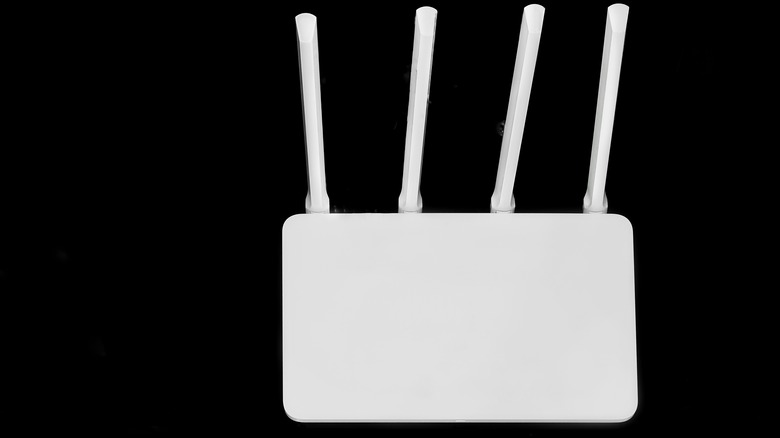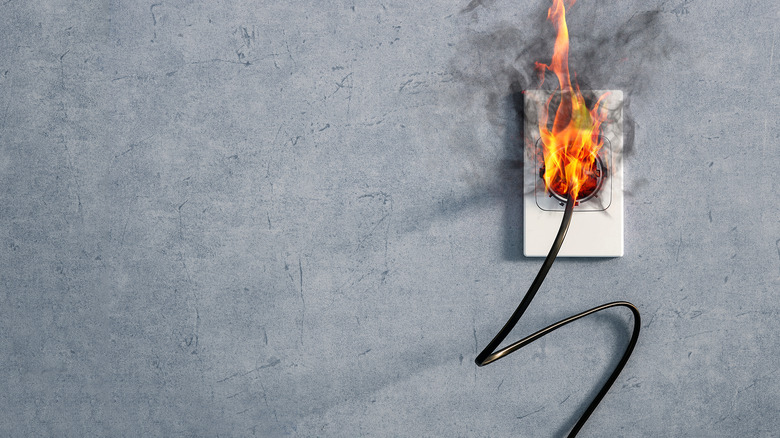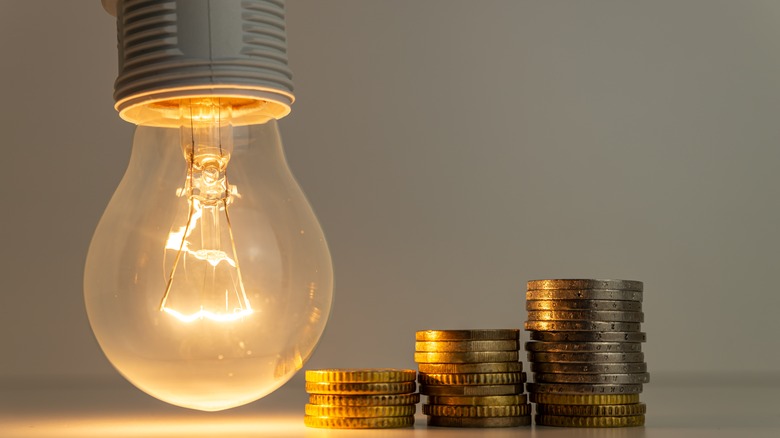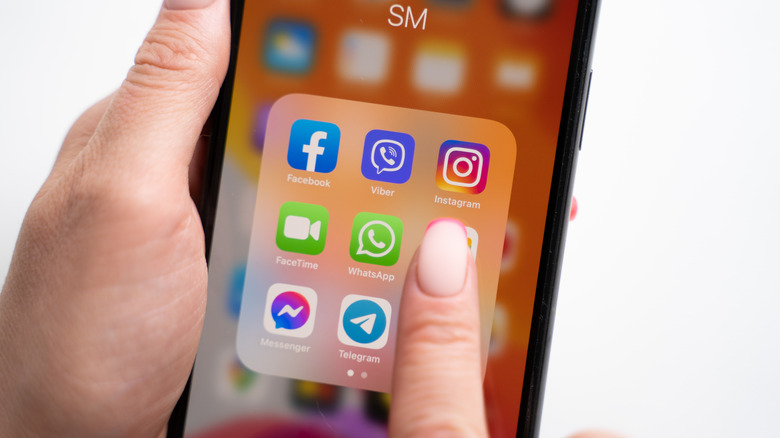

Why You Should Turn Off Your Wi-Fi When Leaving Your House For An Extended Time
source link: https://www.slashgear.com/1162328/why-you-should-turn-off-your-wi-fi-when-leaving-your-house-for-an-extended-time/
Go to the source link to view the article. You can view the picture content, updated content and better typesetting reading experience. If the link is broken, please click the button below to view the snapshot at that time.

Why You Should Turn Off Your Wi-Fi When Leaving Your House For An Extended Time

When leaving the house for an extended period, it's a good idea to turn off or unplug electronic devices that make your life easier. For example, if your water heater is run on a timer, pausing the control unit when you're away will help reduce energy usage and keep the property safer overall.
The same procedures should be kept for your TV, Amazon Alexa devices, and many other tools in your home. One electronic device often overlooked here is the wireless router, which provides the seamless connectivity that a modern household has come to rely on. But opting to leave it switched on – perhaps solely for an immediate reconnection once you walk through the door upon your return – can be a mistake for many reasons. Ask Leo! notes that leaving your router plugged in and functioning while away is acceptable, but only if you utilize its security features to keep your connection safe.
For most, the best course of action is to turn the Wi-Fi router off when leaving for a work-related trip or a holiday away. If your home will be empty for an extended period, turning off electrical equipment is always the best way to proceed. This means unplugging the connectivity equipment, too, for most people.
Security threats become magnified

For the average homeowner, digital security mainly concerns direct attacks: Phishing emails, aggressive pop-ups, or something similar. However, hackers and malicious actors can install all kinds of malware on your network if given enough time uninterrupted.
Criminals need two things to thrive — motive and access. Motive is often straightforward, but access may be harder to come by. When it comes to cybercriminals, leaving your wireless connection online while your house sits unoccupied gives them all the time they need to breach your network, especially if you have minimal defenses. It's possible to tell when someone is using your Wi-Fi, but it's much harder when you don't have direct access to your router.
Unplugging your router severs this connection, making it impossible for a cyber thief to access your network without gaining physical access to your devices. This ensures that your wireless network will remain uncompromised when you return home from work or adventures. While the threat of breach may be slight for many, criminal behavior is typically characterized by opportunity rather than any unique feature you (as the potential victim) bring to the table. Removing this opportunity will reduce the odds that you're targeted.
Surge protection adds a layer of fire risk reduction

In addition to the cyber defense that an unplugged router offers, Lifewire reports that unplugging your electronics, including your router, can help ward off the potential for electrical fires started by an unexpected power surge. While at home, you can handle the fallout in the unlikely event of a power surge. But if your home is left unattended, there will be no one there to manage the plugs in the event of a lightning storm directly overhead or any other type of electrical emergency that warrants action.
Dell notes that surge protection equipment can be built into electronic devices and that their primary function is to mitigate the damage caused by a sudden surge of electricity running through the equipment. Still, suppose you aren't at home to deal with a fried circuit. In that case, the damage could get much worse if you are unlucky enough to have a second lightning strike in the area or another electricity surge caused by a local infrastructure failure.
Real Homes reports that Wi-Fi devices don't pose the same level of fire risk that many other pieces of equipment that may reside in your home. Yet, the danger remains nonetheless, and the task of unplugging one additional box from the wall is as simple a job as any you'll complete during the final checks before leaving the house. The extra seconds required are negligible, but can enhance peace of mind while you're away.
You'll save money on your electricity bill

Finally, Real Homes suggests that the real issue solved by unplugging your Wi-Fi is the excess drain on your electricity usage. While most devices require minimal power from the wall when not in use (for instance, the TV or your PC), your router remains active while it's connected to power. The router always produces a signal that other devices can connect to, and they don't have sleep mode.
The price per kWh rose sharply in 2022 (via U.S. Bureau of Labor Statistics), and there's little hope of this changing any time soon. This means that homeowners should do all they can to reduce the electricity they use daily to protect their finances. Shutting down the Wi-Fi router while you're away for a week — or even just a few days — can make a small but meaningful impact on this front. For electricity usage, every little bit counts toward the goal of lowering usage and the resulting bill. Therefore, this simple act reduces electricity costs over the long term.
10 Common Smartphone Apps That Are Killing Your Data

Over the past decade, the smartphone has gradually positioned itself at the core of human life. Almost every activity today revolves around smartphones, be it interacting with friends, hosting professional collaborations, or relaxing for some entertainment on the weekend. A major reason for this smartphone explosion lies in its versatility: with easy access to the internet and a combination of ever-improving hardware and software features, it enables software developers to build a variety of applications and deliver experiences that people love.
In terms of data consumption, however, some applications may be going too far to deliver these experiences to their users. Obtaining data to use the internet already costs a lot of money: the average American, for instance, spends almost $100 per month and about $1,166 annually on internet plans and streaming subscriptions only (via Reviews.org). And with frequent use of data-demanding apps and services, it is not uncommon to spend up to thrice the average amount on data.
Smartphone apps guzzle data in a variety of ways. Platforms like TikTok, which provides a new and high-quality video with every swipe, consume data through these rapid video downloads. Similarly, classic social media apps like Instagram and Facebook hook users on not only viewing multimedia posted by others but also posting theirs in high quality. And most notoriously, many smartphone apps consume data while running in the background. Today we're taking a look at a few common apps that are also notorious data hogs, along with a few suggestions on how to keep them in check.
Instagram originally rose to fame by focusing on photos. The app still retains some features characteristic of its early release: more emphasis on media (and less on text), high-resolution video and imagery, and of course, filters. Due to these features, it was immediately evident that Instagram would require more data than Facebook — widely perceived as the social media standard of the time — for a smoother experience.
With the addition of more functionality over the years and a change in how users navigate the platform, Instagram's data consumption has certainly increased. In terms of functionality, there are now Instagram Stories and Instagram Reels, more filters and edits for uploading media, and more integrations with third-party apps. With respect to use patterns, there's a noticeable increase in the number of videos posted, as well as stark competition among "insta celebrities" for a presence on the Explore page.
It's no surprise, then, that spending an hour daily on Instagram for a week can run your data balance down by 4.2 GB — if you're only scrolling through your home feed. The app will consume more data during uploads, averaging about 2MB per photo and much more for videos. Instagram users are provided with several options to limit data usage: stop pre-loading of videos, view high-resolution media using Wi-Fi only, or upload low-quality media. But all of these come at the cost of a smooth, fast, and enjoyable experience, which is Instagram's major selling point.
TikTok
Along the stretch of content creation history, short videos stand out as a monumental and desired feature of social media apps. Instagram has Stories and Reels, YouTube has Shorts, and Snapchat videos are concise by design. Currently, though, no app dominates the short video space more strongly than TikTok, a platform that has risen so rapidly among the ranks. There are presently over 1 billion monthly active TikTok users, indicating that the app has outperformed projections to reach this figure by 2025.
Similar to Instagram, TikTok offers a slew of features that encourage its users to upload as frequently as they consume. Spurred by the desire to entertain people from everywhere and the status of having millions of followers, TikTokers spend several hours contributing to and receiving from the platform. But while TikTok's focus on short videos might give the impression that the app is data efficient, this is certainly not the case: users quickly discover that the platform tops the chart of data-guzzling social media apps.
Statistically, one hour of going through your TikTok feed consumes about 840MB of data. Scaling this up to the weekly level, it's easy to see how 10 GB worth of data could be used up by TikTok alone. And users who upload videos frequently can expect to use more than these amounts. All in all, the high data demands of TikTok perfectly illustrate the challenge of managing data for not just one application but the entire suite of smartphone apps run by the user.
YouTube
With up to 500 hours of video uploaded to YouTube per minute, the platform services more than two billion active users every month. An observed feature of frequent YouTube use is the habit of users to binge-watch several videos in one niche — or by one creator — for hours on end. And whether these videos are on the latest tech gadgets or mouth-watering food recipes, viewers will not hesitate to exchange large amounts of data for such content.
But the excitement of using the platform quickly disappears upon receipt of a low data notification. And for many users, this notification comes quicker than expected. A detailed YouTube data usage experiment confirmed that YouTube zaps up to 2.7 GB for every 60 minutes of watching videos at 720p (HD) resolution and high bitrate (via Android Authority). This data consumption rises up to 23 GB per hour at 2160p (4k) resolution, and even at the lowest quality of 144p, the app still uses more than 1 MB per minute of video.
YouTube also consumes data "in advance" by loading videos in a fashion that prevents buffering, such that the first five minutes of a 10-minute video could already be available with the user still at the two-minute mark. Plus, these do not put into perspective the enormous amounts of data required to upload video content, which also varies depending on each video's resolution.
Netflix
Also a video streaming platform, Netflix one-ups YouTube in several categories. The platform specializes in long-form content including movies and series, hosts both cartoons and live-action animated films, and — strangely enough — offers video games for its users. In a fiercely competitive streaming market, Netflix has retained its prominence and popularity: as of the third quarter of 2022, Netflix recorded more than 220 million paid subscribers worldwide.
As might be expected, then, Netflix also one-ups YouTube in terms of high data usage. The data consumption stats for using Netflix on a browser are themselves high: at standard definition, Netflix videos burn through up to 1 GB per hour; and increasing the quality to Full HD or 4k brings the hourly video consumption up to 3 GB or 7 GB respectively. On the mobile app, watching content at the "Maximum Data" mobile data usage setting can swallow more than 1 GB every 20 minutes. And the "Automatic" setting, for balancing video resolution and data expense, takes roughly 1 GB in four hours.
Like YouTube, Netflix also aims for non-buffering in the user experience. A major consequence of loading future parts of a video is that viewers who do not eventually finish a video would have expended more data than they used. To conserve data, in general, Netflix has options to reduce the quality of videos and downloads, watch videos at only a chosen quality, or toggle on the "Save Data" setting that automatically configures the app for reduced data usage.
Google Chrome
Available on both Android and iOS devices, the Chrome browser is Google's ultimate tool for the internet. And as the most popular web browser in the world, Chrome does everything a browser should do and more. By default, the Chrome browser uses a lot of data to access the internet — be it for browsing web pages, reading documents, or viewing multimedia. The platform is optimized for speed, and its smooth experience is offered to the user in exchange for data intensity. And with improvements in smartphone hardware and software, Chrome will continue to evolve.
Depending on the website being visited or task being run, Chrome will consume varying amounts of data per unit time of work. The browser will also utilize data in tracking browsing history, recommending news articles in the Chrome feed, and running background processes to keep browser tabs open. Users can reduce Chrome's data consumption through the "Data Saver" settings on the Chrome app. And though this might compromise browser speed and smoothness, it will go a long way in conserving cellular data.
Snapchat
Launched in 2011, a year after Instagram, Snapchat entered the social media arena with its own idea of novelty. Its unique offerings of intelligent filters and disappearing multimedia caught the attention of social media enthusiasts on the lookout for the next big thing. And many of Snapchat's offerings formed the foundation for modified features on other social media apps, such as Instagram Stories and the filters contained therein. Snapchat has enjoyed significant growth in the number of users year-on-year, and currently, there are about 363 million active daily users of the platform — a testament to its maintained popularity among young people.
For early users of the smartphone app, it didn't take long to discover that Snapchat was a data-demanding software. Utilizing the multiple features provided by the app, for both self-expression and connecting with other Snapchat users, required several megabytes of data. More importantly, Snapchat worked in the background by default to preload Snaps and Stories. All of these contribute to the high data consumption by Snapchat, which can easily reach 20GB per month.
Snapchat helps out users seeking to manage their data by providing a "Data Saver" toggle, which disables the preloading. With this option turned on, users can only download and view Snaps when online and if relevant to them. In fact, it is recommended that this option remains on if the user does not have an unlimited data subscription, or when trying to keep data expenditure below a set limit.
As the app credited for sparking today's social media era, Facebook has continually evolved to keep pace with the competition. Its almost 20-year journey has seen the platform grow from a mere network of friends to an information-sharing site, a marketplace to grow businesses and a top choice for social media influencers. Even after so many years, Facebook still remains populated with users: as of the third quarter of 2022, Facebook had almost 3 billion monthly active users — making it the most utilized social media platform worldwide.
In improving its product offering, Facebook has introduced a host of features over the last few years. This includes its ever-improving interface allowing for a smoother experience, in-app features like Facebook Stories and Reels, and even meetings with Facebook Rooms. Facebook also followed in the footsteps of Instagram to allow for high-resolution media uploads, media autoplay, and preloading. While these features have certainly raised the bar for Facebook as a multifaceted social media platform, they have also contributed to its increased data consumption over time.
To put Facebook's data usage in perspective, merely scrolling through the home feed gulps almost 50 MB in five minutes and up to 480 MB per hour. If there are more videos than average on the feed, users will most likely expend more than these amounts of data. And as with other social media platforms, uploading and sharing media takes its own toll on the data balance. All of these can be managed by configuring Facebook data settings.
Spotify
Just as YouTube dominates the video content space, Spotify is at the pinnacle of music streaming. The platform hosts all kinds and genres of music, providing a significant amount of revenue for music and podcast creators depending on their public streams. Spotify rose to its peak by delivering for both its free and premium customers, and this explains why the platform currently boasts 456 million users and 195 million premium subscribers.
Since its inception in 2006, Spotify has worked to improve the user experience features on its platform. From the app's interface to audio quality, to its integration with automotive audio systems, users can listen to music whenever and however they wish. But in terms of data consumption, Spotify shares the same issue with video streaming platforms like YouTube and Netflix. Music is essentially re-downloaded when it is streamed, and unless a user saves tracks offline, every instance of listening to the same songs would waste data unnecessarily. This is why Spotify offers the option of offline saving for its premium subscribers.
Furthermore, the amount of data consumed depends on the music quality: it was found that listening at normal quality (96kbps) burns 40 MB per hour, and this increases to 70 MB hourly for high quality (160kbps) and 150 MB hourly for extreme quality (320kbps). In this regard, Spotify lets users decide on the quality of music they listen to. Navigating to the "Settings" section of the app, users will also find the option to toggle Automatic quality, which is recommended.
Twitter is another of the world's most popular social media platforms, and it is perhaps one of the most controversial. The Blue Bird app accommodates people from all spheres of life, creating an opportunity for self-expression in a few words. With almost 400 million users globally and over 500 million tweets sent per day, Twitter is the go-to platform for news, trends, entertainment, and political discourse. And all of these come with a huge demand for data, which users can manage using the data usage settings that Twitter provides.
With a 280-character limit on tweets, Twitter aims for users to share information without consuming too many resources. So far, this has worked out well for the platform, in terms of both keeping users engaged and retaining its audience. But Twitter still records a high level of data consumption, which is proof that the users really determine the direction of a smartphone application.
For Twitter, in particular, the prevalence of multimedia — and all the features that support them — is its greatest undoing. Today's Twitter users are accustomed to sharing more images and videos, and going through one's Twitter feed is becoming less different from the experience on Instagram. Twitter also has a default autoplay setting, such that images and videos immediately load when they appear on the screen, regardless of their quality or resolution. Fortunately, the app contains options to reduce cellular data consumption by disabling autoplay, viewing high-quality videos with Wi-Fi only, or never viewing high-quality videos at all.
Ranking among the most popular instant messaging platforms in the world, WhatsApp has become for some the go-to option for sending messages, even preferred over SMS texts. The app is used by more than two billion people worldwide every month, also placing it among the most popular smartphone apps overall. WhatsApp promotes itself as a low-data platform, and to some extent this is true. Text messages and voice notes consume only kilobytes, and even audio calls use less than 1 MB per minute. In addition, WhatsApp has a reputation for reducing media quality and size, which it does by using a compression algorithm. This quality reduction also applies to videos and status updates, and while some users like it for its data-saving effect, others despise it for the unwanted drop in quality.
In any case, these are the low-data features of WhatsApp. Video calls tell a different story: it's estimated that WhatsApp takes up to 5 MB per minute on 4G-based video calls and 3.75 MB per minute on 3G. Moreover, while a single photo, video, or status update may not consume that much data, viewing several media or watching friends' status updates for hours — or uploading these yourself — could drain your data balance. WhatsApp also expends cellular data to back up chats and media to the cloud, and this is one of the features that are limited upon toggling on the "Low Data Usage" setting.
Smartphone & app settings to help reduce data consumption
Given that many of these smartphone apps already feature options to reduce data usage, a lot of data can indeed be saved from the apps alone. The data usage options can usually be found after navigating to "Settings" on the application. Of course, the exact data-saving settings will differ based on the platform: while some might limit the quality of media that you view, others can also limit the quality of media that you upload. And yet others might be focused on saving offline, so you do not have to repeatedly download media. The major advantage of these settings is that the user is positioned to create an optimal experience that, even if not at the highest quality, works just fine for the user.
In addition, smartphone operating systems provide overarching settings to limit data consumption. On the iPhone, users can find the "Low Data Mode" setting to stop data-intensive processes from running in the background, disable automatic downloads, and pause updates to Apple-native apps and services. This option can be found in the "Cellular Data Options" tab of the iPhone settings. Also, Android devices offer multiple settings to monitor and reduce data exhaustion. Navigating to the "Networks & Internet" option (or similar) in the Android settings, users can find toggles to disable auto-sync and data roaming, receive data usage warnings, and automatically turn off mobile data when a limit is reached. With these options, users can manage data optimally.
Recommend
-
 15
15
After natural (or economic) disasters, this new bill would guarantee housing assistance
-
 10
10
Travel- Getting Ready to Be Away from Your PC for an Extended Trip Jun 30, 2002 Travel: Getting Ready to Be Away from Your PC for an Extended Trip Last updated: 7/6/2002; 4:48:38 PM
-
 3
3
Other limitations: Only one stored password for a specific domain can be stolen. LastPass: Autofill occurs only for passwords that have been stored after a successful login Keeper On f...
-
 3
3
APFS vs. Mac OS Extended: Which Should You Pick? By Shujaa Imran Published 15 hours ago Here’s a simple explanation of the tw...
-
 3
3
Get ready to turn all the junk in your house into 3D models with Epic's upcoming app By Daniel Allen Published 6 minutes ago ...
-
 8
8
Should You Ask Instagram Followers to Turn On Notifications for Your Posts? By Aya Masango Published 8 hours ago Here are t...
-
 8
8
Guest How extended reality tactics can benefit your marketing strategy
-
 10
10
ByErin O'BrienPublishedToday 9:00AM
-
 7
7
Guest Why you should embrace the extended reality continuum
-
 1
1
About this Episode Stephanie introduces her ideal setup for enjoying coffee on a bike ride. Joël describes his afternoon tea ritual. Exciting news from the hosts: both have been accepted t...
About Joyk
Aggregate valuable and interesting links.
Joyk means Joy of geeK